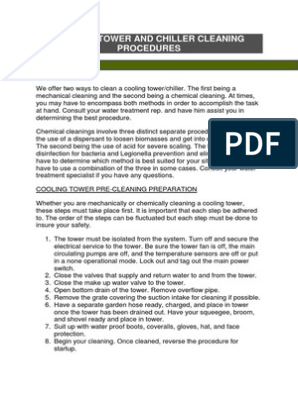0% found this document useful (0 votes)
6 views3 pagesAdobe Scan Jun 25, 2025
The document outlines essential pre-cleaning preparation and a step-by-step cleaning procedure for cooling towers to ensure safety and efficiency. Key steps include shutting down the system, inspecting for damage, wearing PPE, and thoroughly cleaning various components while applying biocides and descalers. Following these guidelines helps maintain equipment longevity and compliance with industry standards.
Uploaded by
asimff84Copyright
© © All Rights Reserved
We take content rights seriously. If you suspect this is your content, claim it here.
Available Formats
Download as PDF, TXT or read online on Scribd
0% found this document useful (0 votes)
6 views3 pagesAdobe Scan Jun 25, 2025
The document outlines essential pre-cleaning preparation and a step-by-step cleaning procedure for cooling towers to ensure safety and efficiency. Key steps include shutting down the system, inspecting for damage, wearing PPE, and thoroughly cleaning various components while applying biocides and descalers. Following these guidelines helps maintain equipment longevity and compliance with industry standards.
Uploaded by
asimff84Copyright
© © All Rights Reserved
We take content rights seriously. If you suspect this is your content, claim it here.
Available Formats
Download as PDF, TXT or read online on Scribd
/ 3




















































































